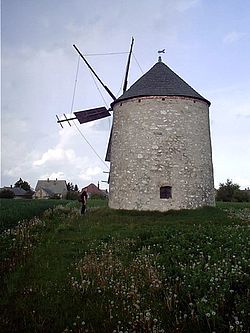Tés
| Tés | ||
|---|---|---|

A windmill in Tés
|
||
|
||
| Location of Tés | ||
| Coordinates: 47°15′22″N 18°01′37″E / 47.25621°N 18.02708°ECoordinates: 47°15′22″N 18°01′37″E / 47.25621°N 18.02708°E | ||
| Country |
|
|
| County | Veszprém | |
| Area | ||
| • Total | 49.03 km2 (18.93 sq mi) | |
| Population (2015) | ||
| • Total | 766 | |
| • Density | 15.6/km2 (40/sq mi) | |
| Time zone | CET (UTC+1) | |
| • Summer (DST) | CEST (UTC+2) | |
| Postal code | 8109 | |
| Area code(s) | 88 | |
Tés is a village in Veszprém County, Hungary.
Tés is one of the most commanding settlements of the Bakony mountain, it can be found on the largest plateau of the East-Bakony at the height of 465 m. The number of residents has been about 900 for ages. According to a legend, the village got its name from King Matthias who spent a lot of time in Várpalota. On one of these occasions, he located prisoners onto the hill that was supposedly the habitat of bears in those days. While selecting the prisoners, he kept repeating ’You too, you too’ that is in Hungarian ’Te is mész, te is mész, te is, te is, te is.’ The name of the village, Tés was born from the contraction of ’te is’. Of course this is just a folktale, in point of fact the origin of the name of the village is unknown.
The first written document, which mentions the village under the name of Tehes, is from 1086. The settlement didn’t have a constant landowner. It was the property of the Benedictine Bakonybél Abbey, it also belonged to the Bakonyi Erdőispánság and paid taxes to almost everybody who had ever been the master of the land.
During the Turkish occupation the number of residents decreased incredibly, what’s more, at the time of Rákóczi's War for Independence it also fell, hence, hardly any residents remained alive in the village. In the 18th century there were resettlements in several cases from the Princedom of Baden, Saxony and different parts of Hungary.
It was primarily the difficult traffic that prevented Tés from improvement. It was burdensome to get to the commanding plateau by animal-drawn vehicles. The construction of the Hungarian-Western railway line was finished in 1872. Thanks to this railway, whose distance was 15 km from the village, people could reach the other parts of the country. At that time, the nearest villages could be approached on foot or by horse only. The first public transport vehicles started to operate in 1956, which meant two buses a day.
...
Wikipedia


